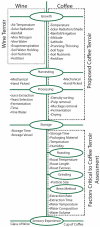Does Coffee Have Terroir and How Should It Be Assessed?
- PMID: 35804722
- PMCID: PMC9265435
- DOI: 10.3390/foods11131907
Does Coffee Have Terroir and How Should It Be Assessed?
Abstract
The terroir of coffee is defined as the unique sensory experience derived from a single origin roasted coffee that embodies its source. Environmental conditions such as temperature, altitude, shade cover, rainfall, and agronomy are considered the major parameters that define coffee terroir. However, many other parameters such as post-harvest processing, roasting, grinding, and brewing can combine to influence the perception of terroir. In this review, we discuss the contribution of these parameters and their influence on coffee terroir. Assessment of terroir requires defined sensory descriptors, as provided by the World Coffee Research Lexicon, and standardized roast level, grind size, and brew method. The choice of the post-harvest processing method is often environmentally dependent, suggesting that an inclusion into the coffee terroir definition is warranted. Coffee terroir is often not intentionally created but results from the contributions of the Coffea species and variety planted, environmental and agricultural parameters, and both the harvest and post-harvest method used. The unique combination of these parameters gives the consumer a unique cup of coffee, reminiscent of the place the coffee was produced.
Keywords: environment; maturation; particle size; post-harvest; roasting; sensory experience.
Conflict of interest statement
The authors declare the project funder, AgriFutures Australia, has no role in the design of the study; in the collection, analyses or interpretation of data; in the writing of the manuscript. The authors declare that the project funder, AgriFutures Australia, has a role in the final decision to publish the results.
Figures







Similar articles
-
The typicity of coffees from different terroirs determined by groups of physico-chemical and sensory variables and multiple factor analysis.Food Res Int. 2018 Dec;114:72-80. doi: 10.1016/j.foodres.2018.07.058. Epub 2018 Jul 31. Food Res Int. 2018. PMID: 30361029
-
Interactive effect of post-harvest processing method, roasting degree, and brewing method on coffee metabolite profiles.Food Chem. 2022 Dec 15;397:133749. doi: 10.1016/j.foodchem.2022.133749. Epub 2022 Jul 20. Food Chem. 2022. PMID: 35901615
-
Roast level and brew temperature significantly affect the color of brewed coffee.J Food Sci. 2022 Apr;87(4):1837-1850. doi: 10.1111/1750-3841.16089. Epub 2022 Mar 29. J Food Sci. 2022. PMID: 35347719 Free PMC article.
-
Microbiota of arabica coffee: insights from soil to fruit.World J Microbiol Biotechnol. 2024 Aug 22;40(10):308. doi: 10.1007/s11274-024-04110-y. World J Microbiol Biotechnol. 2024. PMID: 39172263 Review.
-
Review on factors affecting coffee volatiles: from seed to cup.J Sci Food Agric. 2022 Mar 15;102(4):1341-1352. doi: 10.1002/jsfa.11647. Epub 2021 Nov 29. J Sci Food Agric. 2022. PMID: 34778973 Review.
Cited by
-
Microbiomes associated with Coffea arabica and Coffea canephora in four different floristic domains of Brazil.Sci Rep. 2023 Oct 28;13(1):18477. doi: 10.1038/s41598-023-45465-w. Sci Rep. 2023. PMID: 37898712 Free PMC article.
-
Identifying the origin of Yemeni green coffee beans using near infrared spectroscopy: a promising tool for traceability and sustainability.Sci Rep. 2024 Jun 10;14(1):13342. doi: 10.1038/s41598-024-64074-9. Sci Rep. 2024. PMID: 38858425 Free PMC article.
-
Coffee Yield Stability as a Factor of Food Security.Foods. 2022 Sep 30;11(19):3036. doi: 10.3390/foods11193036. Foods. 2022. PMID: 36230112 Free PMC article.
-
Development of a flavour wheel for Coffea canephora using rate-all-that-apply.Sci Rep. 2025 May 13;15(1):16643. doi: 10.1038/s41598-025-99921-w. Sci Rep. 2025. PMID: 40360712 Free PMC article.
-
Metabolomics as a tool for geographic origin assessment of roasted and green coffee beans.Heliyon. 2023 Oct 30;9(11):e21402. doi: 10.1016/j.heliyon.2023.e21402. eCollection 2023 Nov. Heliyon. 2023. PMID: 38028010 Free PMC article. Review.
References
-
- Decazy F., Avelino J., Guyot B., Perriot J.J., Pineda C., Cilas C. Quality of different Honduran coffees in relation to several environments. J. Food Sci. 2003;68:2356–2361. doi: 10.1111/j.1365-2621.2003.tb05772.x. - DOI
-
- Vaudour E., Costantini E., Jones G.V., Mocali S. An overview of the recent approaches to terroir functional modelling, footprinting and zoning. Soil. 2015;1:287–312. doi: 10.5194/soil-1-287-2015. - DOI
-
- Anesi A., Stocchero M., Dal Santo S., Commisso M., Zenoni S., Ceoldo S., Tornielli G.B., Siebert T.E., Herderich M., Pezzotti M., et al. Towards a scientific interpretation of the terroir concept: Plasticity of the grape berry metabolome. BMC Plant Biol. 2015;15:191. doi: 10.1186/s12870-015-0584-4. - DOI - PMC - PubMed
-
- Van Leeuwen C., Barbe J.-C., Darriet P., Geffroy O., Gomes E., Guillaumie S., Helwi P., Laboyrie J., Lytra G., Le Menn N., et al. Recent advancements in understanding the terroir effect on aromas in grapes and wines. Oeno One. 2020;54:985–1006. doi: 10.20870/oeno-one.2020.54.4.3983. - DOI
Publication types
Grants and funding
LinkOut - more resources
Full Text Sources

